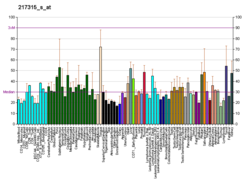| KLK13kmpll | |||||||||||||||||||||||||||||||||||||||||||||||||||
|---|---|---|---|---|---|---|---|---|---|---|---|---|---|---|---|---|---|---|---|---|---|---|---|---|---|---|---|---|---|---|---|---|---|---|---|---|---|---|---|---|---|---|---|---|---|---|---|---|---|---|---|
| Identifiers | |||||||||||||||||||||||||||||||||||||||||||||||||||
| Aliases | KLK13, KLK-L4, KLKL4, kallikrein related peptidase 13 | ||||||||||||||||||||||||||||||||||||||||||||||||||
| External IDs | OMIM: 605505 MGI: 3615275 HomoloGene: 56714 GeneCards: KLK13 | ||||||||||||||||||||||||||||||||||||||||||||||||||
| |||||||||||||||||||||||||||||||||||||||||||||||||||
| |||||||||||||||||||||||||||||||||||||||||||||||||||
| |||||||||||||||||||||||||||||||||||||||||||||||||||
| |||||||||||||||||||||||||||||||||||||||||||||||||||
| Wikidata | |||||||||||||||||||||||||||||||||||||||||||||||||||
| |||||||||||||||||||||||||||||||||||||||||||||||||||
Kallikrein-13 is a protein that in humans is encoded by the KLK13 gene.[4][5][6]
YouTube Encyclopedic
-
1/1Views:1 728
-
KLK 13 September 2016 Ustadz Tengku Zulkarnaen ( Siroh Nabawiyah)
Transcription
Function
Kallikreins are a subgroup of serine proteases having diverse physiological functions.
As of 2022, the precise physiological functions of Kallikrein 13 remain unknown. It may play a role in the defense of the upper digestive apparatus, in extracellular matrix degradation, in tissue remodelling, and in the male reproductive organs.
This gene is one of the fifteen kallikrein subfamily members located in a cluster on chromosome 19. Expression of this gene is regulated by steroid hormones and may be useful as a marker for breast cancer. An additional transcript variant has been identified, but its full length sequence has not been determined.[6]
Kallikrein-13 serves as a priming protease during infection by the human coronavirus HKU1.[7]
Many kallikreins are implicated in carcinogenesis and some have potential as novel cancer and other disease biomarkers.
References
- ^ a b c GRCm38: Ensembl release 89: ENSMUSG00000054046 - Ensembl, May 2017
- ^ "Human PubMed Reference:". National Center for Biotechnology Information, U.S. National Library of Medicine.
- ^ "Mouse PubMed Reference:". National Center for Biotechnology Information, U.S. National Library of Medicine.
- ^ Lundwall A, Band V, Blaber M, Clements JA, Courty Y, Diamandis EP, Fritz H, Lilja H, Malm J, Maltais LJ, Olsson AY, Petraki C, Scorilas A, Sotiropoulou G, Stenman UH, Stephan C, Talieri M, Yousef GM (Jun 2006). "A comprehensive nomenclature for serine proteases with homology to tissue kallikreins" (PDF). Biol Chem. 387 (6): 637–41. doi:10.1515/BC.2006.082. PMID 16800724. S2CID 436200.
- ^ Diamandis EP, Deperthes D, Lundwall Å (Jun 2006). "Proceedings of the 1st International Symposium on Kallikreins, Lausanne, Switzerland, September 1-3 , 2005". Biol Chem. 387 (6): 635–824. doi:10.1515/BC.2006.081. PMID 16800723. S2CID 83910246.
- ^ a b "Entrez Gene: KLK13 kallikrein-related peptidase 13".
- ^ Milewska A, Falkowski K, Kulczycka M, Bielecka E, Naskalska A, Mak P, Lesner A, Ochman M, Urlik M, Diamandis E, Prassas I, Potempa J, Kantyka T, Pyrc K (2020). "Kallikrein 13 serves as a priming protease during infection by the human coronavirus HKU1". Science Signaling. 13 (659): eaba9902. doi:10.1126/scisignal.aba9902. PMC 7857416. PMID 33234691.
Further reading
- Diamandis EP, Yousef GM, Luo LY, et al. (2001). "The new human kallikrein gene family: implications in carcinogenesis". Trends Endocrinol. Metab. 11 (2): 54–60. doi:10.1016/S1043-2760(99)00225-8. PMID 10675891. S2CID 25806934.
- Yousef GM, Chang A, Diamandis EP (2000). "Identification and characterization of KLK-L4, a new kallikrein-like gene that appears to be down-regulated in breast cancer tissues". J. Biol. Chem. 275 (16): 11891–8. doi:10.1074/jbc.275.16.11891. PMID 10766816.
- Yousef GM, Chang A, Scorilas A, Diamandis EP (2000). "Genomic organization of the human kallikrein gene family on chromosome 19q13.3-q13.4". Biochem. Biophys. Res. Commun. 276 (1): 125–33. doi:10.1006/bbrc.2000.3448. PMID 11006094.
- Gan L, Lee I, Smith R, et al. (2001). "Sequencing and expression analysis of the serine protease gene cluster located in chromosome 19q13 region". Gene. 257 (1): 119–30. doi:10.1016/S0378-1119(00)00382-6. PMID 11054574.
- Chang A, Yousef GM, Jung K, et al. (2002). "Identification and molecular characterization of five novel kallikrein gene 13 (KLK13; KLK-L4) splice variants: differential expression in the human testis and testicular cancer". Anticancer Res. 21 (5): 3147–52. PMID 11848466.
- Chang A, Yousef GM, Scorilas A, et al. (2002). "Human kallikrein gene 13 (KLK13) expression by quantitative RT-PCR: an independent indicator of favourable prognosis in breast cancer". Br. J. Cancer. 86 (9): 1457–64. doi:10.1038/sj.bjc.6600283. PMC 2375362. PMID 11986781.
- Strausberg RL, Feingold EA, Grouse LH, et al. (2003). "Generation and initial analysis of more than 15,000 full-length human and mouse cDNA sequences". Proc. Natl. Acad. Sci. U.S.A. 99 (26): 16899–903. Bibcode:2002PNAS...9916899M. doi:10.1073/pnas.242603899. PMC 139241. PMID 12477932.
- Petraki CD, Karavana VN, Diamandis EP (2003). "Human kallikrein 13 expression in normal tissues: an immunohistochemical study". J. Histochem. Cytochem. 51 (4): 493–501. doi:10.1177/002215540305100411. PMID 12642628.
- Komatsu N, Takata M, Otsuki N, et al. (2003). "Expression and localization of tissue kallikrein mRNAs in human epidermis and appendages". J. Invest. Dermatol. 121 (3): 542–9. doi:10.1046/j.1523-1747.2003.12363.x. PMID 12925213.
- Petraki CD, Gregorakis AK, Papanastasiou PA, et al. (2004). "Immunohistochemical localization of human kallikreins 6, 10 and 13 in benign and malignant prostatic tissues". Prostate Cancer Prostatic Dis. 6 (3): 223–7. doi:10.1038/sj.pcan.4500674. PMID 12970725. S2CID 21609011.
- Kapadia C, Yousef GM, Mellati AA, et al. (2004). "Complex formation between human kallikrein 13 and serum protease inhibitors". Clin. Chim. Acta. 339 (1–2): 157–67. doi:10.1016/j.cccn.2003.10.009. PMID 14687906.
- Grimwood J, Gordon LA, Olsen A, et al. (2004). "The DNA sequence and biology of human chromosome 19". Nature. 428 (6982): 529–35. Bibcode:2004Natur.428..529G. doi:10.1038/nature02399. PMID 15057824.
- Kapadia C, Ghosh MC, Grass L, Diamandis EP (2004). "Human kallikrein 13 involvement in extracellular matrix degradation". Biochem. Biophys. Res. Commun. 323 (3): 1084–90. doi:10.1016/j.bbrc.2004.08.206. PMID 15381110.
- Gerhard DS, Wagner L, Feingold EA, et al. (2004). "The status, quality, and expansion of the NIH full-length cDNA project: the Mammalian Gene Collection (MGC)". Genome Res. 14 (10B): 2121–7. doi:10.1101/gr.2596504. PMC 528928. PMID 15489334.
- Darling MR, Jackson-Boeters L, Daley TD, Diamandis EP (2006). "Human kallikrein 13 expression in salivary gland tumors". Int. J. Biol. Markers. 21 (2): 106–10. doi:10.1177/172460080602100206. PMID 16847813. S2CID 7038149.




